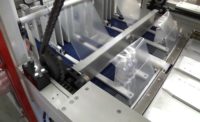EDL Launches Improved Double Tight Wrap DTW 25 Shrink Bundling System

The new and improved Double Tight Wrap DTW 25 shrink-wrapping machine by EDL applies two perpendicular bands of LDPE film to tightly unitize and totally enclose multipacks of packaged products. The system uses servo controls to manage the sealing of up to 25 bundles per minute., which is 12% faster than previous similar size models and requires up to 30% less floor space. Additionally, the DTW 25 system uses up to 40% less film than traditional total enclosure shrink packaging systems.
The DTW 25 double tight wrap system was designed for the secure bundling of gable-topped, bagged and pouched products, as well as large bags of granular products like lawn care products These products can shift within their primary packaging, making it difficult to create stable pallet loads. This system uses clamps to align bags precisely prior to wrapping and seals the finished tight wraps with Teflon-coated constant-heat jaws, creating a totally sealed bundle.
The system also can bundle other products, including bagged granular pet foods and cat litter, beans, building products, medical goods, surgical kits and food service consumables such as nested fiber trays and cup holders.
Following application, the two opposing wraps are fused during heat shrinking to integrate them into a stable unit that eliminates shifting of the packaged products. This makes the packages easier to integrate into pallet loads and simpler to offload and move by retail customers. Since the process does not fuse the wrapping film to the primary packaging, the bundles are easily opened by the retailer and bagged product quickly shelved.
EDL offers multiple layout options for the DTW 25 to accommodate the unique production line needs of specific customers. Systems can be laid out, for example, in “U” or “Z” formats, or in other configurations. The DTW 25, like all EDL machines, is designed for production flexibility, and to allow for future production line upgrades. The system is constructed with an easy-to-clean design to allow frequent cleaning and to meet regulatory requirements.
Looking for a reprint of this article?
From high-res PDFs to custom plaques, order your copy today!






